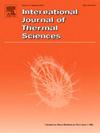Antimicrobial desiccant-crosslinked hydrogel beads for air dehumidification
IF 4.9
2区 工程技术
Q1 ENGINEERING, MECHANICAL
International Journal of Thermal Sciences
Pub Date : 2025-02-12
DOI:10.1016/j.ijthermalsci.2025.109776
引用次数: 0
Abstract
The rising demand for space cooling and the need to reduce carbon footprints have spurred interest in alternative air-conditioning systems. Desiccant systems, known for their energy efficiency and high moisture capture capacity, offer a promising solution. This study presents novel alginate beads, synthesized through crosslinking with magnesium chloride-potassium formate desiccant mixture at concentrations of 25 w/v% (B1), 50 w/v% (B2), and 75 w/v% (B3) for application in a desiccant system. The beads were characterized using FESEM, FTIR, XRD, DSC, and TGA to identify the optimal desiccant concentration while the absorption kinetics were modeled using the pseudo-second-order approach. Results indicated that B2 exhibited superior performance in absorption rate, thermal stability, and pore size distribution compared to B1 and B3. Additionally, all samples demonstrated antibacterial properties, enhancing air quality during dehumidification. Moisture removal performance was evaluated experimentally using a fixed bed dehumidifier system under varying air mass flow rate (ma), specific humidity (ω), and temperature (Ta). Optimization through response surface methodology (RSM) identified the optimal conditions of ma, ω and Ta as 0.374 kg/s, 0.0243 kg/kg, and 29.7 °C respectively, yielding a predicted maximum moisture removal rate (MRR) of 6.814 g/s. Experimental validation showed a deviation of ±4.3 %, confirming the accuracy and reliability of the results. The proposed hydrogel beads demonstrated notable advantages over traditional solid desiccants in terms of enhanced thermal stability and antibacterial properties, while maintaining significant moisture absorption capacity, making them an excellent choice for energy-efficient dehumidification.

求助全文
约1分钟内获得全文
求助全文
来源期刊

International Journal of Thermal Sciences
工程技术-工程:机械
CiteScore
8.10
自引率
11.10%
发文量
531
审稿时长
55 days
期刊介绍:
The International Journal of Thermal Sciences is a journal devoted to the publication of fundamental studies on the physics of transfer processes in general, with an emphasis on thermal aspects and also applied research on various processes, energy systems and the environment. Articles are published in English and French, and are subject to peer review.
The fundamental subjects considered within the scope of the journal are:
* Heat and relevant mass transfer at all scales (nano, micro and macro) and in all types of material (heterogeneous, composites, biological,...) and fluid flow
* Forced, natural or mixed convection in reactive or non-reactive media
* Single or multi–phase fluid flow with or without phase change
* Near–and far–field radiative heat transfer
* Combined modes of heat transfer in complex systems (for example, plasmas, biological, geological,...)
* Multiscale modelling
The applied research topics include:
* Heat exchangers, heat pipes, cooling processes
* Transport phenomena taking place in industrial processes (chemical, food and agricultural, metallurgical, space and aeronautical, automobile industries)
* Nano–and micro–technology for energy, space, biosystems and devices
* Heat transport analysis in advanced systems
* Impact of energy–related processes on environment, and emerging energy systems
The study of thermophysical properties of materials and fluids, thermal measurement techniques, inverse methods, and the developments of experimental methods are within the scope of the International Journal of Thermal Sciences which also covers the modelling, and numerical methods applied to thermal transfer.
 求助内容:
求助内容: 应助结果提醒方式:
应助结果提醒方式:


